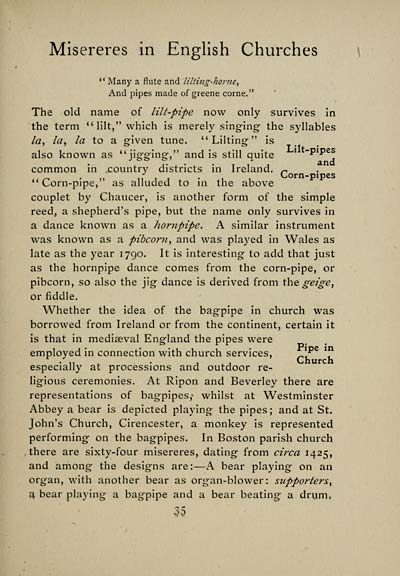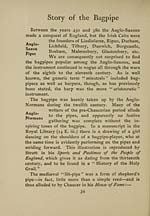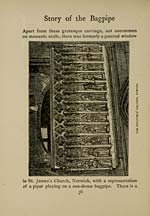Inglis Collection of printed music > Printed text > Story of the bagpipe
(61) Page 35
Download files
Complete book:
Individual page:
Thumbnail gallery: Grid view | List view

Misereres in English Churches
" Many a flute and lilling-horm,
And pipes made of greene come."
The old name of lilt-pipe now only survives in
the term "lilt," which is merely singing- the syllables
la. la. la to a given tune. "Liltin°f" is
also known as "jigging," and is still quite ' "P'P"
common in country districts in Ireland. .-,
. ,,ii • Lorn-pipes
"Corn-pipe, as alluded to in the above
couplet by Chaucer, is another form of the simple
reed, a shepherd's pipe, but the name only survives in
a dance known as a hornpipe. A similar instrument
was known as a pibcorn, and was played in Wales as
late as the year 1790. It is interesting to add that just
as the hornpipe dance comes from the corn-pipe, or
pibcorn, so also the jig dance is derived from the geige,
or fiddle.
Whether the idea of the bagpipe in church was
borrowed from Ireland or from the continent, certain it
is that in mediaeval England the pipes were
employed in connection with church services, ~! pe ! f
.... . , Church
especially at processions and outdoor re-
ligious ceremonies. At Ripon and Beverley there are
representations of bagpipes,- whilst at Westminster
Abbey a bear is depicted playing the pipes; and at St.
John's Church, Cirencester, a monkey is represented
performing on the bagpipes. In Boston parish church
there are sixty-four misereres, dating from circa 1425,
and among the designs are:— A bear playing on an
organ, with another bear as organ-blower: supporters,
a bear playing a bagpipe and a bear beating a drum,
35
" Many a flute and lilling-horm,
And pipes made of greene come."
The old name of lilt-pipe now only survives in
the term "lilt," which is merely singing- the syllables
la. la. la to a given tune. "Liltin°f" is
also known as "jigging," and is still quite ' "P'P"
common in country districts in Ireland. .-,
. ,,ii • Lorn-pipes
"Corn-pipe, as alluded to in the above
couplet by Chaucer, is another form of the simple
reed, a shepherd's pipe, but the name only survives in
a dance known as a hornpipe. A similar instrument
was known as a pibcorn, and was played in Wales as
late as the year 1790. It is interesting to add that just
as the hornpipe dance comes from the corn-pipe, or
pibcorn, so also the jig dance is derived from the geige,
or fiddle.
Whether the idea of the bagpipe in church was
borrowed from Ireland or from the continent, certain it
is that in mediaeval England the pipes were
employed in connection with church services, ~! pe ! f
.... . , Church
especially at processions and outdoor re-
ligious ceremonies. At Ripon and Beverley there are
representations of bagpipes,- whilst at Westminster
Abbey a bear is depicted playing the pipes; and at St.
John's Church, Cirencester, a monkey is represented
performing on the bagpipes. In Boston parish church
there are sixty-four misereres, dating from circa 1425,
and among the designs are:— A bear playing on an
organ, with another bear as organ-blower: supporters,
a bear playing a bagpipe and a bear beating a drum,
35
Set display mode to: Large image | Transcription
Images and transcriptions on this page, including medium image downloads, may be used under the Creative Commons Attribution 4.0 International Licence unless otherwise stated. ![]()
| Special collections of printed music > Inglis Collection of printed music > Printed text > Story of the bagpipe > (61) Page 35 |
|---|
| Permanent URL | https://digital.nls.uk/94509908 |
|---|
| Description | Scottish and English songs, military music and keyboard music of the 18th and 19th centuries. These items are from the collection of Alexander Wood Inglis of Glencorse (1854 to 1929). Also includes a few manuscripts, some treatises and other books on the subject. |
|---|
| Description | The Glen Collection and the Inglis Collection represent mainly 18th and 19th century Scottish music, including Scottish songs. The collections of Berlioz and Verdi collected by bibliographer Cecil Hopkinson contain contemporary and later editions of the works of the two composers Berlioz and Verdi. |
|---|

